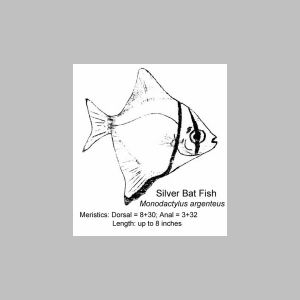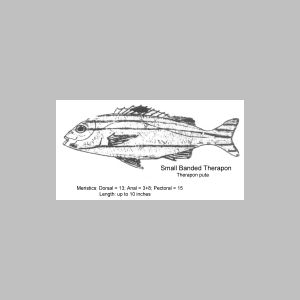Bulletin 3 - October 1977: Fishes of Abu Dhabi 2
Fishes of Abu Dhabi 2
by Roger BrownIn the second part of this series we take a look at two more fish common to the Abu Dhabi and Gulf area, the Monodactylus argenteus and Therapon puta.
Monodactylus argenteus
This fish, from the monodactylidal family, is sometimes referred to as a Mono but the common English names used are either Moon Fish or Silver Bat Fish. The Arabic name used is Farsuk.
Description
As the sketch shows, this fish has a very deep flat body with very prominent dorsal and anal fins. The body has a silver coloring and has small scales. There are two distinctive rear vertical black bands, one passing through the eye, the other through the operle. The fins have a yellowish tint and the anal bears the dark band from the operle.

M. argenteus has been seen locally at lengths of four inches and is known to attain a length of up to eight inches at maturity (Trucial States Council -- vol. 1, 1971 -- common fishes of the Arabian Gulf and Gulf of Oman).
Habits and Habitat
This fish prefers shallow waters preferably around coral or rocky areas. It is quite a lively schooling fish and has been observed in numbers of up to about 20, alongside the Abu Dhabi Hilton breakwater and also certain coral reef areas out to sea from the Batin. Their movement is very graceful and often appear to hover for a minute or more undisturbed. When this happens they are able to change their body coloration from bright to dark and usually dart away into a rocky or coral crevice.
M. argenteus enjoys a balanced diet, feeding on both animal and vegetable edible matter.
Therapon puta
Common English name: Small Banded Therapon
Arabic: Zamrool
This fish should not be confused with T. jarba or T. theraps, which have very similar markings, and are from the same family (Theraponidal).
Description
As the sketch shows this is a perch-like fish having a silvery body, but pinky white belly and marked with four brown horizontal bands. These bands are more prominent towards the topside of the fish and are usually marked through the semi-transparent caudal fin (tail). The lips appear slightly pink and the pectoral and pelvic fins are of a yellowish color and have a sharp barb (or spine) associated with them. The first and second dorsal fins are semi-transparent white in color. A black mark appears at the tip of the first dorsal fin, but can only be observed when the fin is fully extended.

T. puta has been observed to grow to lengths up to 10 inches (Fishes of Kuwait -- K.I.S.R.) but only seen around Abu Dhabi at lengths of up to six inches.
Habits and Habitat
Although basically open seas fish, they can often be found scavenging around coral reefs and rocks for food. They are carnivorous and have voracious appetites. They will readily seize upon any small fry in the area.
They seldom swim alone, preferring to shoal. Shoals of 100 or more have been observed near the Hilton breakwater (a favorite haunt of mine as you can see).
During the mating period, T. puta become very territorial, vigorously defending their habitat. A rather impressive display of their defense has been observed. when on Terapon encroaches on another area, the resident fish swims out with dorsal fins fully extended and darts, with mouth wide open, at the encroaching fish. This usually frightens off the encroaching fish. However, sometimes the new fish takes up the challenge by similarly extending its dorsal fin and opening its mouth. This head to head display continues until one of the fish backs away, at which point the triumphant fish chases the other away, returning to reside in its new habitat.